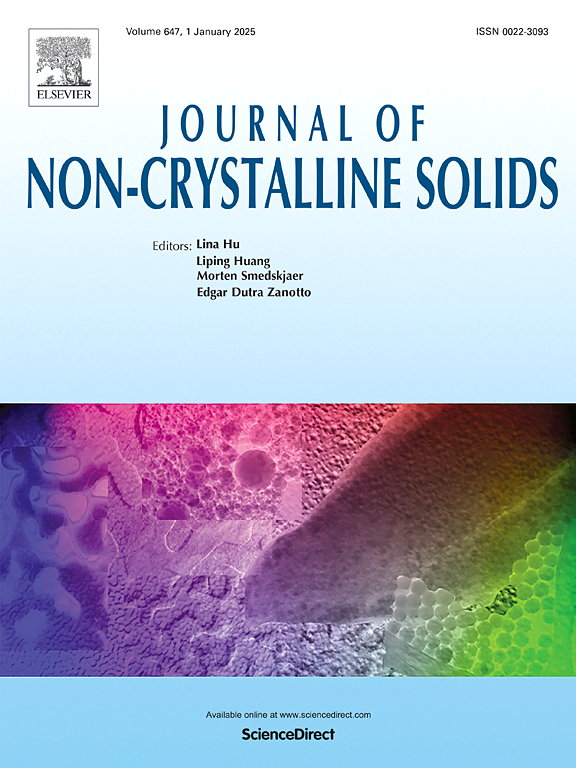Rapid fabrication of diamond-like carbon coating with excellent corrosion resistance by low-voltage plasma electrolytic deposition
IF 3.2
3区 材料科学
Q1 MATERIALS SCIENCE, CERAMICS
引用次数: 0
Abstract
Diamond-like carbon (DLC) coatings were rapidly synthesized on the surface of AISI 304 austenitic stainless steel by utilizing a low-voltage plasma electrolytic deposition (PED) method with an acetonitrile solution. The results show that, as the deposition time increases, the intensity ratio of the D and G peaks (ID/IG) in Raman spectroscopy initially rises and then subsequently declines, the lowest value of which is 1.17 for the coating deposited at 260 V for 60 min, and X-ray photoelectron spectroscopy (XPS) analysis indicates that the sp3-C content of which achieves to 63.63 %. As for the coating deposited at 260 V for 60 min with the thickness of 2.4 μm demonstrates a superior corrosion resistance in 3.5 wt.% NaCl solution, comparison to the untreated stainless steel, the corrosion potential of which increases from -0.540 V to -0.418 V, the corrosion current density decreases from 9.294 × 10–6 A/cm2 to 3.603 × 10–6 A/cm2, and the polarization resistance rises from 5375 Ω·cm2 to 12,181 Ω·cm2. The present DLC coating with excellent corrosion resistance will be suitable for corrosion protection of metallic materials in marine environments. Analysis of the corrosion mechanisms reveals that coatings with a higher sp3-C content exhibit lower electrical conductivity, which restricts electron transport within the coating surface. Therefore, the DLC coating with a higher sp3/sp2 ratio displays superior corrosion resistance.

低压等离子体电解快速制备耐腐蚀类金刚石涂层
采用乙腈溶液低压等离子体电解沉积(PED)方法在AISI 304奥氏体不锈钢表面快速合成了类金刚石(DLC)涂层。结果表明:随着沉积时间的延长,拉曼光谱中D、G峰的强度比(ID/IG)先上升后下降,在260 V下沉积60 min时,其强度比最低为1.17,x射线光电子能谱(XPS)分析表明,其sp3-C含量达到63.63%。在3.5 wt.% NaCl溶液中,厚度为2.4 μm、260 V沉积60 min的涂层具有较好的耐蚀性,腐蚀电位从-0.540 V增加到-0.418 V,腐蚀电流密度从9.294 × 10-6 a /cm2降低到3.603 × 10-6 a /cm2,极化电阻从5375 Ω·cm2增加到12,181 Ω·cm2。目前所研制的DLC涂层具有优异的耐腐蚀性,适用于海洋环境中金属材料的防腐。腐蚀机理分析表明,sp3-C含量越高,涂层的电导率越低,这限制了涂层表面的电子传递。因此,具有较高sp3/sp2比值的DLC涂层具有较好的耐腐蚀性。
本文章由计算机程序翻译,如有差异,请以英文原文为准。
求助全文
约1分钟内获得全文
求助全文
来源期刊

Journal of Non-crystalline Solids
工程技术-材料科学:硅酸盐
CiteScore
6.50
自引率
11.40%
发文量
576
审稿时长
35 days
期刊介绍:
The Journal of Non-Crystalline Solids publishes review articles, research papers, and Letters to the Editor on amorphous and glassy materials, including inorganic, organic, polymeric, hybrid and metallic systems. Papers on partially glassy materials, such as glass-ceramics and glass-matrix composites, and papers involving the liquid state are also included in so far as the properties of the liquid are relevant for the formation of the solid.
In all cases the papers must demonstrate both novelty and importance to the field, by way of significant advances in understanding or application of non-crystalline solids; in the case of Letters, a compelling case must also be made for expedited handling.
 求助内容:
求助内容: 应助结果提醒方式:
应助结果提醒方式:


